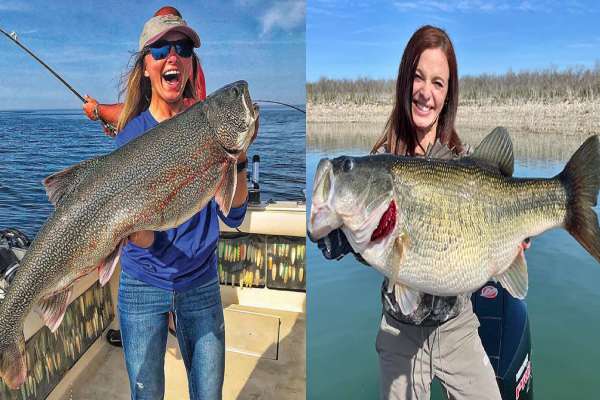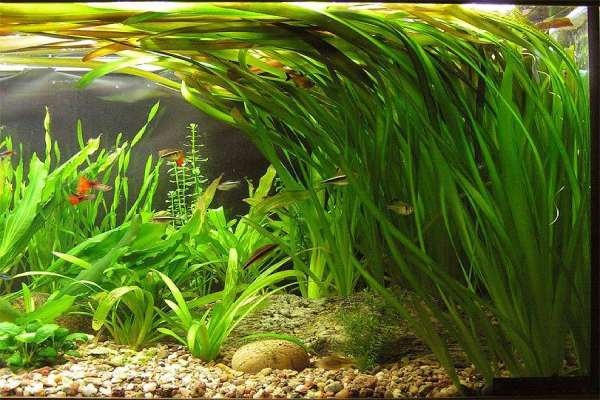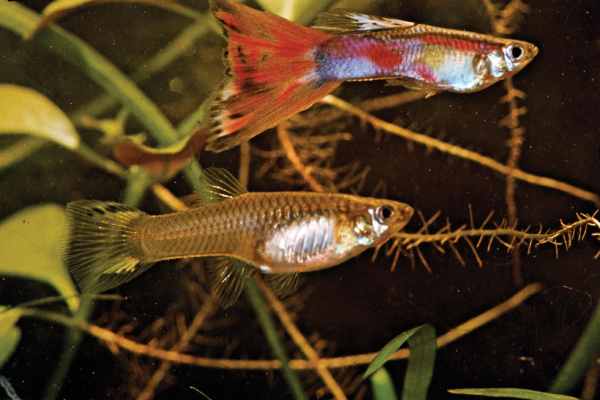Trout vs. Bass Fishing: Which Is The Best?
Bass and trout are popular fish that attract anglers of all skill levels. While both fish offer unique experiences, they are significantly different in terms of species and taxonomy, physical characteristics, habitat and distribution, feeding behavior, and fishing techniques.
Understanding these distinctions will not only enable you to differentiate between the two of them but also enable you to spot which one is better.
In this blog post, we will compare and contrast bass and trout fish, highlighting the key distinctions between the two species, including their hook sizes, preferred weather, location, and fishing techniques.

We will also explore why trout has gained immense popularity and discuss elaborately which of these two fishes is more enjoyable to catch and which tastes the best, so keep scrolling.
Trout vs bass
There are a number of differences between trout and bass, and in this section, we will go over the major differences between them.
Species and Taxonomy
Bass belongs to the family Centrarchidae. They are a diverse group of fish that include popular species such as Largemouth bass, smallmouth bass, and striped bass.
Trout, on the other hand, are members of the salmonid family, the Salmonidae. Rainbow trout, brown trout, and brook trout are all common types of trout.
Physical Characteristics
You can easily identify bass and trout by their unique physical characteristics. Bass are larger, more muscular fish with a wide snouts, a big mouth, and just one dorsal fin. They can be greenish or brownish, with black vertical stripes or blotches, and have a deep, laterally compressed body shape.
Trout, on the other hand, has a slimmer, more aerodynamic body. They are notable for their bright colors and small scales. For example, rainbow trout have a silvery body with a pink or red lateral stripe and dark patches along their back.
Habitat and Distribution
When it comes to habitat, bass and trout have quite different habitat and distribution preferences.
Bass are freshwater fish that thrive in warm environments like lakes, ponds, rivers, and reservoirs. Vegetation is a common habitat for these creatures, so you can keep an eye out for them in places like wetlands, wood piles, and flower gardens.
Bass are able to thrive in both clear and murky water and are found frequently in both.
On the other hand, trout are typically found in chilly, clean water. They thrive in water that is low in temperature and has a high oxygen content. Typically, trout habitats feature rocky terrain, deep pools, and strong currents. Read about keeping trout in a garden pond if you need the full guide.
Feeding Behavior
Bass are noted for their aggressive feeding habits and ability to quickly adapt to new environments.
They devour anything smaller than themselves, whether it be fish, insects, crustaceans, or even rodents and birds.
Ambush hunting is a common tactic for bass, in which they surprise their victim with a burst of speed after lurking in cover.
Trout, on the other hand, are pickier eaters. They eat things like crustaceans, tiny fish, and water insects.
Fly enthusiasts frequently target trout by casting artificial flies that simulate natural prey, taking advantage of their sensitivity to tiny motions.
Here are other differences between Trout and Bass
| Tout | Bass |
| Trout are distinguished by their slim, sleek bodies, vivid colors, and tiny scales. | The body of a bass is more substantial, and its mouth and jaw are noticeably larger and more pronounced. |
| Trout encompasses several species such as rainbow trout, brown trout, and brook trout, each with its unique characteristics. | Bass encompasses various species, including largemouth bass, smallmouth bass, and striped bass, differing in size and behavior. |
| Trout usually need gravel beds in running water to reproduce. | Bass females usually lay their eggs in nests that the males have built for them along the water’s edge. |
| Anglers use fly rods or light spinning setups with small lures or bait to capture trout. | Bass fishing, on the other hand, typically involves trolling, casting larger lures, and using baitcasting reels. |
| Trout are typically associated with colder environments, such as those found in the highlands. | Bass are widespread throughout the world’s freshwater systems. |
| Trout are known for their incredible speed and agility in the water, allowing them to skim over currents and snag their food with ease. | Bass, on the other hand, favor ambush tactics when cruising and have a more casual swimming style. |
| Trout spawn in the spring when water temperatures are milder and conditions are favorable. | Bass, especially largemouth bass, spawn in the late spring and early summer when water temperatures are at their highest. |
The main differences between bass and trout fishing
Although many anglers like both bass and trout fishing, these two species have quite different requirements in terms of hook size, ideal weather and location, and fishing technique.
You’ll have a much better time fishing and a higher probability of success if you take the time to familiarize yourself with these differences. Let’s take a look at these key distinctions.
Hook Sizes
One of the most noticeable distinctions between bass fishing and trout fishing is the size of the hooks used.
Due to the size and strength of bass, larger hooks are normally used while fishing for them. Their hook size ranges from 4 to 6/0 depending on the bait and fishing conditions.
When fishing for trout, however, anglers typically use smaller hooks, anything from size 14 to 8. Smaller hooks are required to properly place hooks on trout, as their jaws are more delicate.
Weather and Location
When and where you can catch bass and trout depends on factors like the weather and the local ecosystem.
Fishing for bass is possible year-round because bass can survive in a wide range of water temperatures. They can be found in lakes, rivers, and ponds.
Submerged vegetation, downed trees, and rocky structures are some of their favorite hiding spots.
During the warmer months, when water temperatures are higher, bass fishing is typically more fruitful.
Fishing for trout requires a body of water with colder temperatures, such as a stream, river, or lake.
They thrive in colder temperatures and clean, oxygenated water. The water temperatures in the spring and fall are ideal for trout fishing.
Fishing Techniques
Bass and trout are targeted with distinct fishing methods due to their distinctive habitats and environments.
Bass are frequently easier to catch since they are more active feeders. Crankbaits, spinnerbaits, jigs, soft plastic baits, and topwater lures are some of the most frequently used lures for casting and trolling.
Bass are also known for their ambush tendencies, so casting near cover and retrieving the bait in a way that mimics their prey’s movements is a very effective technique you can use to catch them.
You know, trout are generally more selective and sensitive to their surroundings, so you’ll need to adjust your fishing techniques accordingly.
Trout fishing methods that actually work typically require greater refinement and precision.
Common techniques you should try include fly fishing with artificial flies, using lightweight spinning or baitcasting gear with live bait, or using small lures like spinners and spoons.
Trout are quickly scared by loud noises or other disturbances, making stealth and precision essential for catching them.
Why trout fishing is so popular
Here are some of the reasons why trout fishing has become extremely popular;
Thrilling Challenges
Trout are known for their elusive nature and impressive fighting ability, making them a challenging catch.
The fast swimming speed and cautious nature of these fish in clear water present anglers with exciting opportunities to test their skills and strategies.
Wide Distribution
You can find trout in rivers, lakes, and streams all over the world; thus, they are abundant and easy to find.
Because of its extensive availability, trout fishing is enjoyed by fish enthusiasts in many different regions.
Which fish is more fun to catch?
Bass and trout are both enjoyable to catch, but which one is more exciting to reel in depends on you. Each of these fish provides a unique experience.
Bass, in particular largemouth bass, are fierce fighters. When hooked, they often put up a fight that will get your blood pumping.
However, their explosive topwater strikes and acrobatic leaps make them an exhilarating species you can pursue.
Unlike bass, trout exhibit a combination of agility and finesse. Their characteristic bursts of speed and darting movements can create thrilling moments for you.
As earlier said, trout often require delicate presentations and precise casting techniques.
Which is easier to catch?
Another interesting question that most fish enthusiasts ask is, “Bass vs trout, which is easier to catch?”. Well, the short answer is bass.
However, factors including location, time of year, and your skill can affect how difficult or easy it is to catch bass or trout.
Trout require you to have more skill and patience compared to brass. Also, many lakes and reservoirs have bass populations that outnumber trout populations, making them abundant compared to trout.
Which fish tastes better?
The flavor and taste of trout are preferred by many anglers and seafood lovers.
Trout flesh has a delicate, mild, and slightly nutty flavor. Its flesh is tender and moist, with a subtle sweetness that may be highly appealing to you.
Trout is one of the best freshwater fish for cooking, and you can serve it in a variety of ways (including grilling, baking, and pan-frying).
However, the taste of bass can vary depending on the species and the waters they inhabit.
For instance, largemouth bass may have a slightly stronger flavor compared to other species. Bass tend to store more pollutants like mercury in their meat than trout do because of the water they inhabit, which may alter their flavor.
Conclusion
You can expect different rewards and difficulties from bass and trout fishing. While larger hooks and warmer water are fine for bass fishing, smaller hooks and more oxygenated water are ideal for trout fishing.
Bass fishing typically involves more forceful approaches, while trout fishing necessitates a greater degree of subtlety and precision.
Bass are more enjoyable to capture because of their aggressive strikes and fierce fights, while trout are more enjoyable because of their quickness and elegance.
However, knowing the differences between these two fish will enable you to capture them without much stress. You can also use the fishing techniques discussed in this blog post to capture any of the two fish.
Read Also: Can You Keep Trout In Your Garden Pond? Expert Guide
FAQs
Bass can be lured by different foods, including topwater lures, crankbaits, spinnerbaits, and plastic worms.
The optimum time to go trout fishing varies depending on the species and the area. Spring and fall, when water temperatures are often more pleasant, are peak times for trout activity. However, brown trout and other trout species are known to be active throughout the entire year.
Though there are specialized rods available for both trout and bass fishing, it is not necessary to have a separate rod for each species of fish you intend to catch.




![Koi Fish Tail Anatomy [Exploring Koi Fins & Tail]](https://aquifacts.com/wp-content/uploads/2024/03/koi-fish-tail-anatomy_img.jpg)

